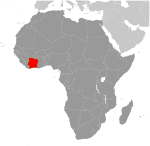| Republic of Côte d'Ivoire République de Côte d'Ivoire
Origin of Name
originally known as the Ivory Coast, a reference to the
country's historic importance in the trade of ivory
Location west Africa
Bordered By Liberia, Guinea, Mali, Burkina Faso, Ghana

Area 124,504 sq mi
(322,463 sq km)
Greatest Distance E-W 411 mi (661 km)
Greatest Distance N-S 420 mi (676 km)
Highest Point Monts Nimba; 5,748 ft (1,752 m)
Lowest Point sea level
Natural Resources petroleum,
natural gas, diamonds, manganese, iron ore, cobalt,
bauxite, copper, gold, nickel, tantalum, silica sand,
clay, hydropower
Nationality Ivoirian
Population (June 2014 est) 22,848,945
Largest Cities Abidjan, Abobo, Bouaké
Ethnic Groups Akan, Voltaiques
(Gur), Northern Mandes, Krous, Southern Mandes
Religions Muslim, Christian,
indigenous
Languages French (official), tribal
Capital Yamoussoukro
Form of Government republic
Present Constitution Adopted July 23,
2000
Chief of State President Alassane Dramane
Ouattara (since December 4, 2010)
Head of Government Prime Minister Daniel
Kablan Duncan (since November 21, 2012)
Cabinet Council of Ministers
Legislature unicameral National Assembly
(Assemblee Nationale)
Judiciary Supreme Court (Cour Supreme)
Local Administration 12 districts, 2 autonomous
districts
Currency Cooperation
Financiere en Afrique Centrale Franc (XAF)
Per Capita Income $1,800
Industries foodstuffs, beverages;
wood products, oil refining, gold mining, truck and bus
assembly, textiles, fertilizer, building materials,
electricity
Agriculture coffee, cocoa beans,
bananas, palm kernels, corn, rice, cassava (manioc,
tapioca), sweet potatoes, sugar, cotton, rubber; timber
Export Commodities cocoa, coffee,
timber, petroleum, cotton, bananas, pineapples, palm oil,
fish
Import Commodities fuel, capital
equipment, foodstuffs
Independence From France Achieved August 7, 1960
National Holiday Independence Day,
August 7
Flag orange symbolizes the land
(savannah) of the north and fertility, white stands for
peace and unity, green represents the forests of the
south and the hope for a bright future
SEE ALSO
Liberia
Guinea
Mali
Burkina
Faso
Ghana
France
Questions or comments about this
page?
|
 SKC Films Library
SKC Films Library